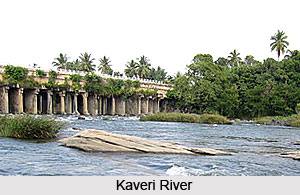The Chola kingdom stretched along the eastern coast, from the river Penner to the Vellar, and on the west reaching to about the borders of Coorg. According to tradition, the Chola country comprised the land between two streams having the same name, Vellaru, in the north and the south, the sea on the east and Kottaikkarai in the west. The area included the modern districts of Trichinopoly and Tanjore and part of the Pudukkottah State. Its capital was Uraiyur. Kaviri-pattinam or Pugar on the northern bank of the river Kaveri was its great port while Kanchi was one of its chief towns. The Chola country was thus drained by the Kaveri River and comprised the districts of Trichinopoly and Tanjore. The origin of the name Chola is uncertain. The name Chola, however, indicated from the earliest times the people as well as the country subject to the Chola dynasty of rulers.
History states that the Chola kings were alleged to belong to the tribe of Tiraiyar or `Men of the Sea`. In the Markandeya Purana, Vayu Purana and Matsya Puranas, the Cholas are mentioned along with the Pandyas and Keralas. In Ramayana, Sugriva is described as sending his monkey followers to the countries of the Cholas, Pandyas and Keralas in quest of Sita. The rock edicts of Ashoka has mentioned that the Cholas, Pandyas, Ketalaputras and Satiyaputras as forming ` prachamta` or outlying provinces outside his empire.  They were on friendly terms with him. The Cholas, like the Pandyas, are spoken of in the plural in all the versions of the Asokan edicts, and this has been held to imply that in Asoka`s time there were more than one Chola and one Pandya King.
They were on friendly terms with him. The Cholas, like the Pandyas, are spoken of in the plural in all the versions of the Asokan edicts, and this has been held to imply that in Asoka`s time there were more than one Chola and one Pandya King.
According to the historical account it can be said that the early history of the Chola country is obscure. About the beginning of the Christian era the Chola king was Peru-nar-Killi. His son was Ilanjet-Senni whose son was Karikal, a vigorous ruler, under whom the Colas became the leading power of the south. He had defeated an allied army of the Cheras and Pandyas and had made an expedition to the north. At home he suppressed the turbulent Ayar, Aravalar, Kurumbar and Oliyar. He made his capital at Kaveri-pattinam on the Kaveri and he secured it from flood by raising the banks of the river as well as by making canals. From the Cholas the hegemony of the south passed to the Cheras and later to the Pandyas. The latter were ousted by the Pallavas, who later on became the suzerain power of Southern India.



















